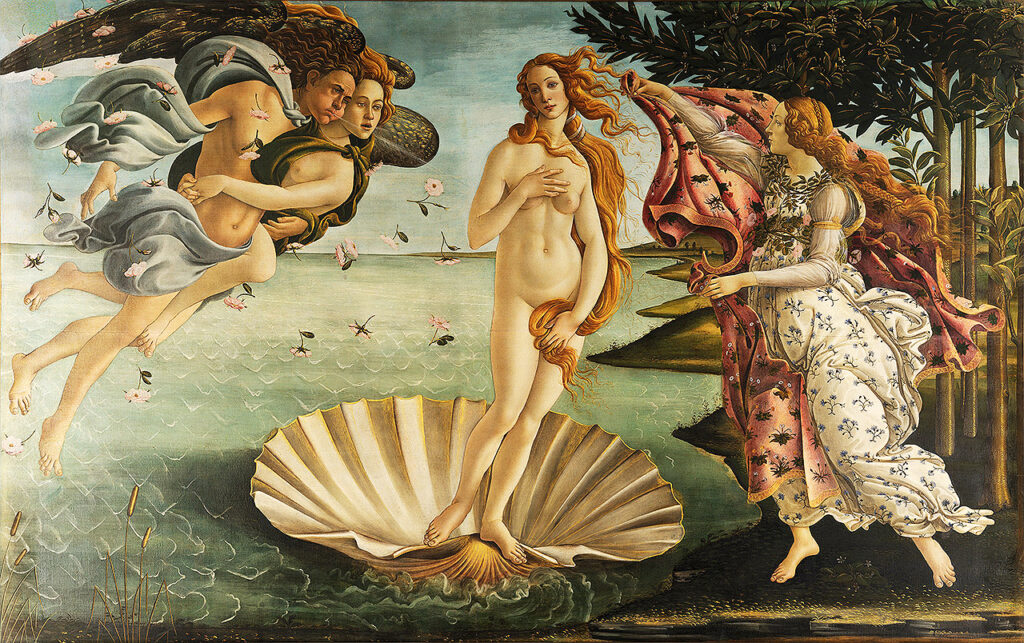
Click here to see a larger version of the painting
Name: The Birth of Venus
Artist: Sandro Botticelli (1445 – 1510)
Date Painted: c.1485
Period: High Renaissance
Dimensions: 172.5 cm (h) x 278.5 cm (w)
Medium / Material: Tempera on Canvas
Location: The Uffizi Gallery, Florence
Other: The Birth of Venus is widely regarded as a companion piece of Sandro Botticelli’s masterpieces, Primavera – Allegory of Spring
Introduction to The Birth of Venus
The Birth of Venus is one of the most recognizable paintings in the world. Right up there along side the Mona Lisa, Starry Night and The Creation Adam. The painting itself is visually captivating but it is the characters, the subject matter, the vibrancy and the composition which invites you to be transported in to another world. This masterpiece of the high renaissance was, at the time, groundbreaking for many different reasons but is still as appealing today, as it was in 1485, when it was completed.
In this article we explore this masterpiece and get to know Sandro Botticelli (the artist) a little better too. This will be a journey back to the 1400s as we see how Botticelli broke boundaries to depict, feminism, fertility, sex, love, and marriage at a time where almost all of the artwork produced was religiously themed.
Location and History
It is widely accepted that the original home of The Birth of Venus was the Villa di Castello. The painting hung on the walls alongside Primavera, Botticelli’s allegory of spring. It is important to understand that The Birth of Venus and Primavera are linked – Not in the sense that the two are Diptychs (Joined together by a hinge etc.) but they should be viewed as companion pieces in my opinion. Both paintings were obviously created by the same artist but they were both commissioned by the Medici family. Primavera is widely regarded to have been a wedding present from Lorenzo de’ Medici (il Magnifico) to his cousin Lorenzo di Pierfrancesco de’ Medici and his bride, Semiramide. The Birth of Venus came a couple of years later but the ownership, patronage, subject matter, style and even color palette suggests that the two pieces were intended to be kept together. Gorgio Vasari clearly documents this in his book. The Lives of the Most Excellent Painters, Sculptors, and Architects when recording Botticelli’s works
Two of these paintings are still at Castello, Duke Cosimo’s villa: one depicts the Birth of Venus, and those breezes and winds which blew her and her Cupids to land; and the second is another Venus, the symbol of Spring, being adorned with flowers by the Graces
Gorgio Vasari – The Lives of the Most Excellent Painters, Sculptors, and Architects
So now that we know that the two paintings resided in the same home, we can start to question why. It is obvious that a painting whose main attraction is Venus, has something to do with love but as with most artwork from the high renaissance, there is a always a deeper meaning that only the cleverest of Florentines would have understood. As mentioned earlier, Primavera was given as a wedding present. A few years later a second Botticelli turns up with a mystical birth right at the center of the painting and strong inferences of love, fertility and baptism. Now this is only my opinion and I have not read this anywhere else but as I was researching the painting, it felt to me that the second painting was a nudge for the newly married couple to have a baby. in 1487, 2 years after the painting was completed Lorenzo and Semiramide began having children (Pierfrancesco, Laudomia and Ginevra).
Theme of The Birth of Venus
Surprisingly, the theme of the The Birth of Venus is not actually the birth of Venus, the Roman goddess of love. Instead it is shortly after her birth where she arrives upon the shores of Cyprus in a giant scallop shell. Naturally, she is assisted by Zephyr, god of the western wind who is carrying his wife, Chloris, in his arms. The actual birth of Venus is a somewhat more graphic tail which involves castrated genitals being cast in to the sea and Venus (also known as Aphrodite in Greek mythology) emerging from the sea foam. As mentioned above, this painting was likely a gift to a young married couple. Botticelli, wisely, did not choose the castration scene to adorn the walls of a country villa but instead opted for the moments after her birth which is a far more majestic scene and one more appropriate for the walls of a Medici retreat.
The Greek poet Homer, author of the Iliad and the Odyssey, captured this moment in one of his Hymns. (Hymn Number 6 to be specific) Many people believe that this hymn is the literal writings that Botticelli used to create his masterpiece. An extract from the translation of the hymn can be seen below
Of august gold-wreathed and beautiful Aphrodite
Homer – Hymn number 6 to Aphrodite, translation: Athanassakis
I shall sing, to whose domain belong the battlements
of all sea-laved Cyprus where, blown by the moist breath of Zephyros,
she was carried over the waves of the resounding sea
in soft foam. The gold-filleted Horae
happily welcomed her and clothed her with heavenly raiment
Botticelli, given his status with the Medici family, would have had access to this translation and been able to create the painting using these texts.
Composition of The Birth of Venus
The composition of the painting is very simple. We have four, full length figures who have been placed on the same viewing plane but turned at different angles. I have highlighted each character in greater detail below. The composition used by Botticelli is very similar to a painting completed in 1475 by Andrea del Verrocchio and his young pupil, Leonardo da Vinci, The Baptism of Christ
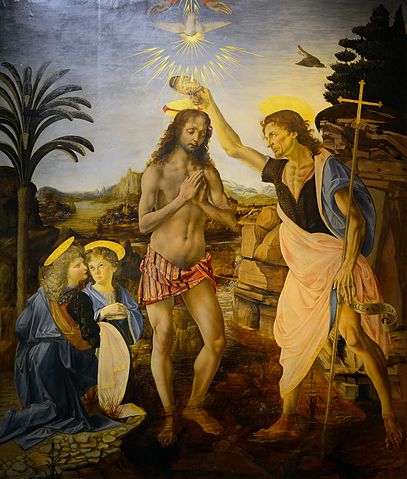
In the painting above you can see the similarities in the composition. Four figures where the dominant figure commands your attention in the center of the painting. We then have a figure on the right (side on view) with a raised arm and two figures to the left. This very similar composition is also seen in one of the bronze panels on the Florence baptistery North doors.
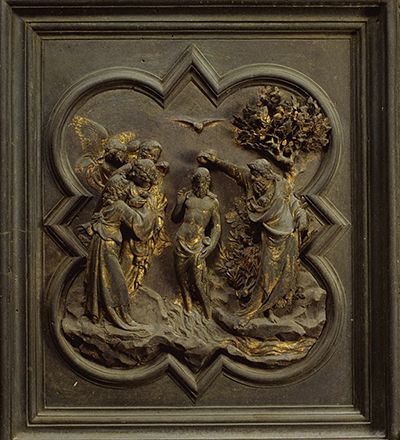
Lorenzo Ghiberti created the north doors between 1403 – 1424. Ghiberti is of course, the master behind a second set of doors for the baptistery which were later described by Michelangelo as the “Gates of Paradise. It is very likely that Ghiberti was the inspiration for Verrocchio’s composition as well as Botticelli’s – plagiarism, between artists back in renaissance of course, was indeed the highest form of flattery.
Balance is one of the key visual aspects in the painting and something to pay close attention to. Remember that you are not viewing something from this mortal realm, these are gods. They do not need to confirm to the laws of gravity, nor do they need to cast shadows. So lets take a closer look at the main characters in the painting
Venus
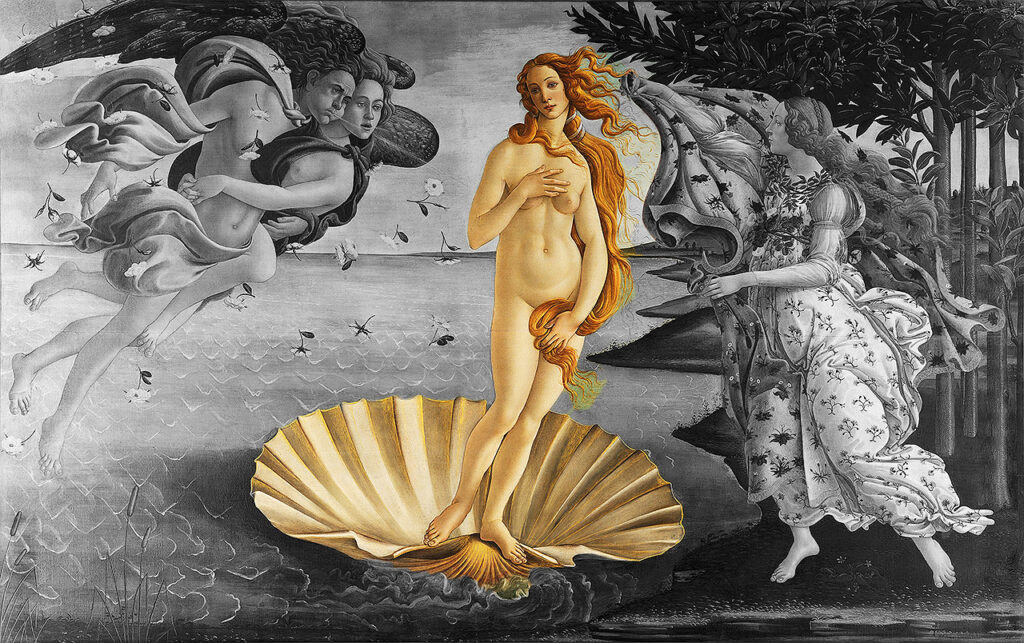
The Birth of Venus is widely regarded to be the first painting to show a fully sized, half naked woman. Until this point naked women had only been displayed as a representation of sin or shame. The image of a naked Eve being expelled from the garden of Eden being the most common representation. (check out the Masaccio painting from 1425 for a good reference point). But Botticelli opts for a different visual. Venus, the goddess of love is beautiful and proud, extremely fitting for the high renaissance where man (or in this case woman) is the measure of all things. Venus is arriving at the shores of Cyprus on a scallop shell and you can see that she is being blown to shore by Zephyr & Chloris. There is a beautifully imbalanced balance to Venus in the painting. Venus is in a contrapposto pose, this means that she standing with the majority of her weight on one leg (her left leg). This pose allows for a natural curve of the body as the hips align. You can clearly see that she is being blown to shore and even with her weight on her front foot, at the front of her shell, there is no signs of danger that she will topple over – after all, she is a goddess.
The relaxed nature of her pose is visibly clear to see in her facial expression. There has been many writings about the facial expression of Venus and one of my favorite things about art is that 100 different people can look at a painting and think 100 different things. when I look at Venus I see an innocent expression that says “Hi, I am Venus” unbeknown that she is the goddess of love and the most beautiful woman in the world. The pose of Venus is a very common pose in renaissance artwork. It is known at the Venus Pudica. In this pose a female form is naked and covering her breast with her right hand and covering the genital region with the left hand. Again, it is worth mentioning that naked woman in art at this time was scarcely seen and only in a portrayal of shame or sin – there is no shame on the face of our Venus here.
Zephyr and Chloris
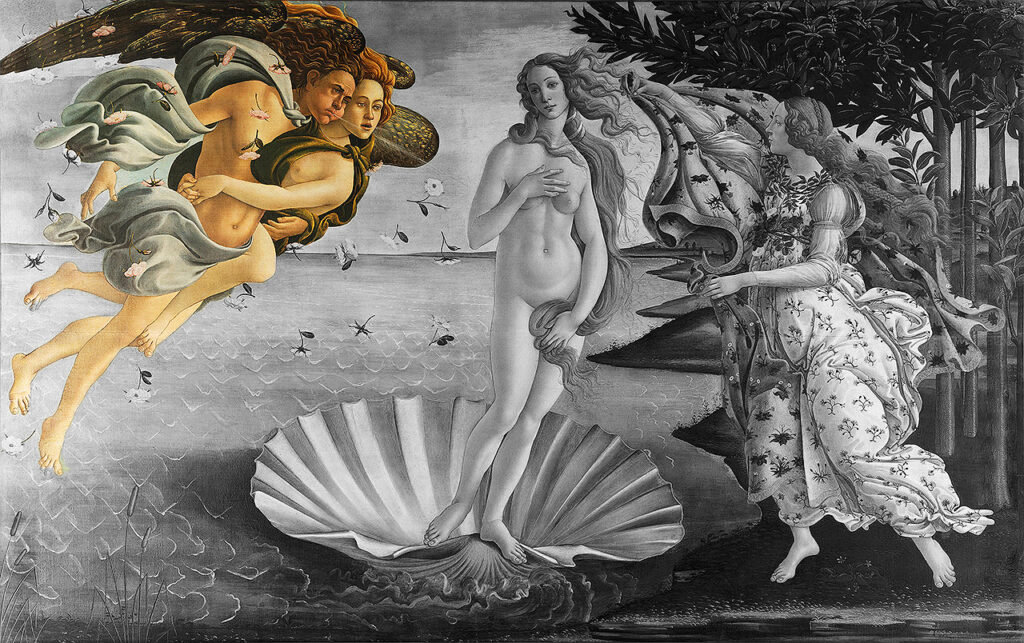
Botticelli is once again using Zephyr and Chloris as leading roles in his paintings. In Primavera, Zephyr is being shown as a haunting figure who is about to kidnap and then rape his future bride, Chloris. This depiction of the god of the western wind is far easier on the eye. He is vibrant and strong blowing the goddess of love to shore – simply doing what a wind god does best. One of the most captivating features of this painting is the wonderful sense of movement that Botticelli has captured. In a time before video cameras were invented, to capture a dynamic snapshot in time was the skill of a true master. Botticelli’s Zephyr & Chloris seem weightless but there are extremely dynamic and you can tell they are moving swiftly. The flowers surrounding them appear to have been stirred up furiously and the waves at their feet are travelling towards the shell as if something above has forced them in that direction.
The expression of Zephyr is somewhat amusing to me. On one hand he is clearly blowing the goddess of love to the shore but I think there is a slightly awkward expression which suggests that he is tired of carrying Chloris and cannot wait to get home – That is of course all in my imagination because no god would ever feel that way and no clever Florentine would ever depict a man as being tired of his wife. The way Chloris clings to Zephyr is almost like an impossible illusion. Again, weightless in a side saddled clutch.
The painting is well balanced and it is the presence of Zephyr & Chloris which gives it this stability. Venus is clearly leaning forward and if you focus only on her, you may find yourself tilting your head and falling head over heels for the goddess of love. However, if you stand back and take in the picture as a whole there is a fine balance that is made possible by our figures on the left.
The addition of Zephyr & Chloris
Hora of Spring
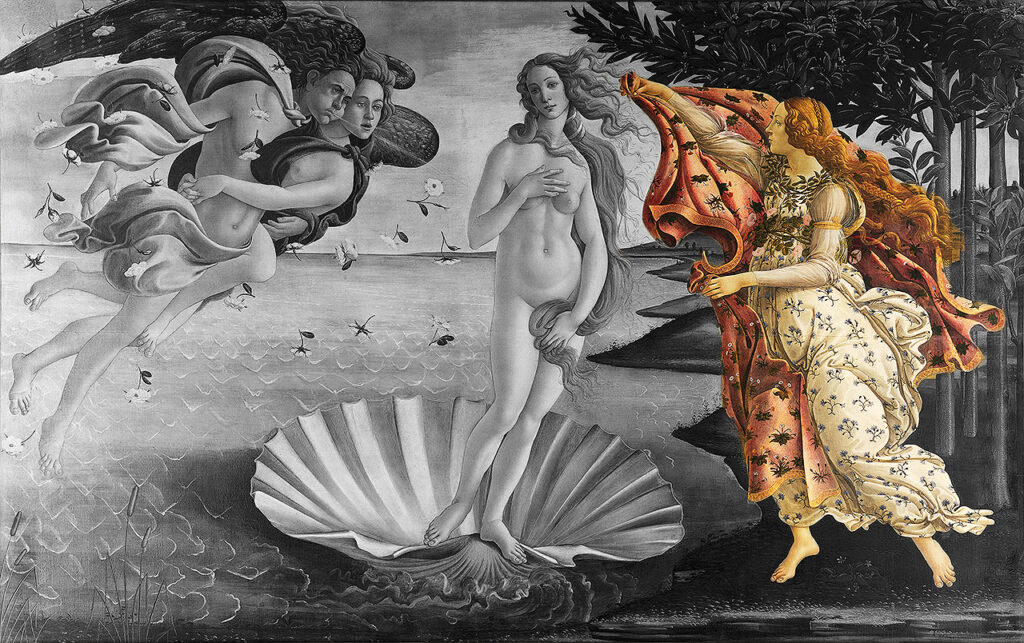
The figure on the right is Hora of Spring (or Horae). In Greek mythology, the Horae were the personifications of the seasons. Asper Homer’s hymn, “The gold-filleted Horae
happily welcomed her and clothed her with heavenly raiment”. Botticelli has captured this line exquisitely in visual form. Botticelli has shown his talent for painting textiles on many occasions and this is no exception. The cloth that Hora is rushing towards Venus with is extremely high quality and adorned with beautiful flowers. Flowers are highly symbolic in Botticelli’s paintings and each one is chosen with intent. This was very similar in Primavera and Venus follows suit. On the red cloak we have red and white daisies which symbolize purity and innocence. The daisy itself is often used to symbolize childbirth, motherhood and new beginnings. In old Norse, the daisy is used to depict the goddess of love. On the white dress we have an abundance of flowers which include blue cornflowers, yellow primroses which both are used to symbolize birth, spring and fidelity. Hora is also wearing a necklace of Myrtle, a symbol of Venus. Round her waist is a rose wreath, again symbology of Venus
At the feet of Hora are anemone flowers – these flowers symbolize the coming of spring, a suggestion that with the arrival of Venus, the land will begin to flourish
The Background
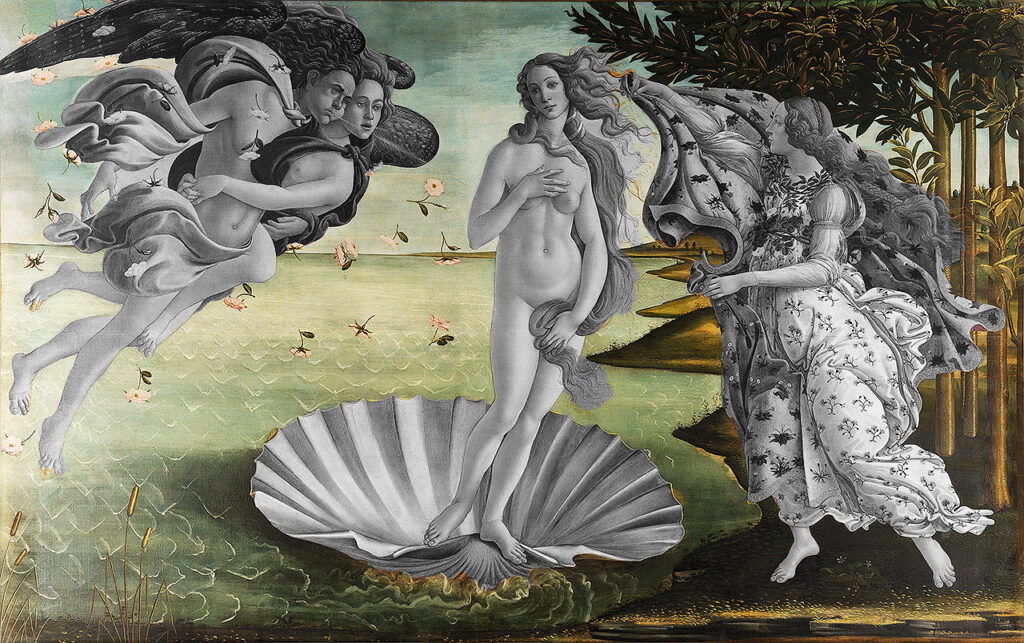
In the background we have further examples of Florentine symbolism as well as a little bit of mischief. On the right we have orange trees, a tilt of the cap towards the Medici family (orbs / oranges can be found on the Medici family crest). The seascape is underwhelming and using a color palette which can only be described as drab. Botticelli may not have wanted to take any focus away from the main characters of the painting by creating a distracting background, or maybe he was not fond of Cyrpus.
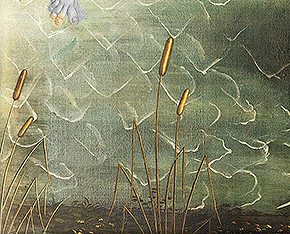
In the bottom left corner of the painting there are bullrushes (see image above). Botanically speaking, these plants have no place in the scene therefore we have to assume that Botticelli is up to something mischievous. Because of their phallic appearance, we can assume that it is something of a sexual nature. It could be in reference to the origins of Venus, the severed genitals that were cast in to the see but it could also be encouragement for the owners of the painting to start a family. Either way, evidence again of Botticelli’s willingness to push boundaries and express a little mischief in his mythological paintings
Summary
The irony of this painting is that that is not actually The Birth of Venus. It is instead the arrival of Venus, a detail which probably goes overlooked all over the world. What is not overlooked is that this is a true masterpiece of the renaissance period and something which still attracts fascinated viewers today. I have been to the Uffizi gallery in Florence and have stood in the presence of this painting (my picture below) – something that I would encourage all art lovers to experience
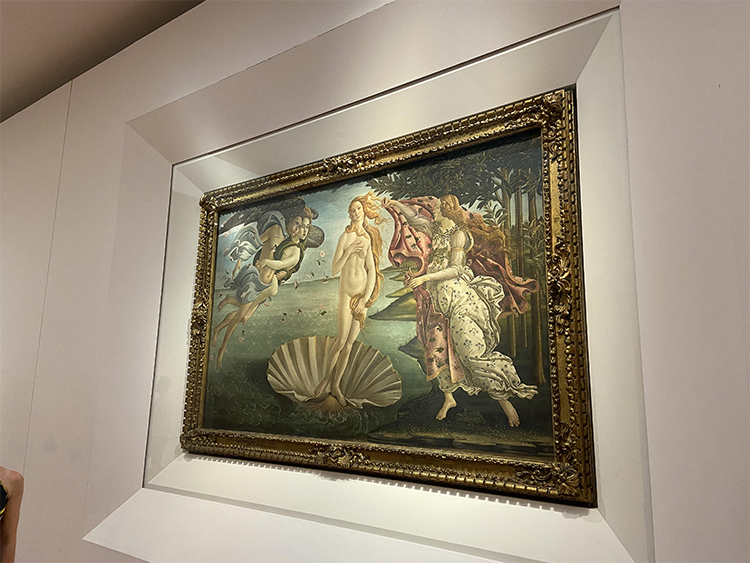
This painting is one of my favorites from the renaissance for many reasons, I personally am always interested by mythological subject matter but when you think that it was ground breaking for so many reasons and that there are layers of mischief and symbology involved, it only adds top the intrigue. They say that you die twice in this world…The first time when you die and the second when that last person speaks your name. Botticelli has no doubt immortalized himself with this painting as we are still talking about him over 500 years later and we are still taking about The Birth of Venus